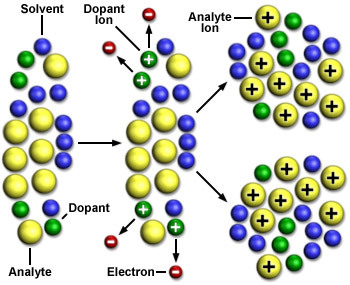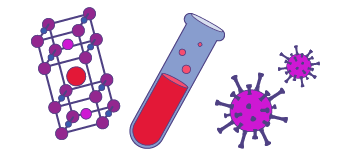All mass spectrometers require the molecules to be in the gas phase and charged (ionized either positive or negative). In this technique, UV light photons are used to ionize sample molecules. The technique works well with nonpolar or low-polarity compounds not efficiently ionized by other ionization sources.
First the sample (analyte) is mixed with a solvent. Depending on the type used, the solvent could increase the number of ions that are formed.
The liquid solution is then vaporized with the help of a nebulizing gas such as nitrogen, then enters an ionization chamber at atmospheric pressure. There, the mixture of solvent and sample molecules is exposed to ultraviolet light from a krypton lamp. The photons emitted from this lamp have a specific energy level (10 electron volts, or eV) that is just right for this process: high enough to ionize the target molecules, but not high enough to ionize air and other unwanted molecules. So only the analyte molecules proceed to the mass spectrometer to be measured.
First, we’ll look at what happens when just the solvent and analyte molecules are exposed to the UV light. Then we will look at the slightly more complicated, and much more typical, scenario in which a dopant (a kind of additive) is introduced into the mixture.
Once they are exposed to the UV light, the analyte molecules are ionized in two ways.
A minority of them will be ionized directly by the UV light (photoionization). As depicted in the equation below, the photons (hν) will excite the analyte molecule (M) enough to cause the loss of an electron (e-), creating a radical cation (M+• ) that will, thanks to its newly acquired positive charge, continue to the mass spectrometer.
This equation is represented in the upper result shown in the graphic below:

Some of the analyte molecules can be indirectly ionized with the help of the solvent molecules. This is shown in the lower result of the graphic, and in the text and equation below.
The photons also excite the solvent molecules (which far outnumber the analyte molecules). Since the molecules are at atmospheric pressure, there are billions of molecular collisions per second. For a small fraction of these collisions, the result is a chemical reaction in which the solvent molecule donates a proton (depicted by an H below) to the analyte molecule (protonation). The process and outcome depends on the particular solvent used, but generally speaking, this solvent-assisted chemical ionization looks like this:
So you end up with two types of ions (M+• and [M + H]+) from one compound, which then proceed to the MS to be analyzed.
The above section explains the basics of APPI, but most of the time APPI is not done exactly that way. That’s because, by adding a third compound called a dopant, you can increase the percentage of analyte molecules that get ionized, improving results. Different compounds can be used; toluene is a commonly used dopant at the MagLab and elsewhere. Like the direct method described above, the dopant method also yields two types of analyte ions, as shown in the equations and graphic below.

First, the dopant molecules are ionized directly by the UV photons. Because the dopant molecules far outnumber the analyte molecules, there can be many more collisions that result in formation of an ion. Then one of two things can happen. The dopant ion can donate a proton to the analyte molecule …
… or the dopant ion receives an electron from the analyte molecule:
Either way, the result is an ionized sample molecule.
What makes this technique useful is its ability to ionize a diverse range of compounds. The type of UV light is important. Here, a krypton UV lamp was used that produced enough energy to ionize the dopant or sample but not enough to ionize other atmosphere gases. If non-sample ions were to be formed, they could interfere with the signal from the sample or even cause an unwanted reaction with the sample. However, this technique does heat the analyte solution to high temperature (250-350° C), so it is less suitable for molecules susceptible to thermal degradation, such as proteins.

Explore our magnet schedule to see what exciting research is happening on our stellar fleet of instruments right now.
For more information please contact Amy McKenna, Manager, ICR User Program.
Last modified on 23 December 2022